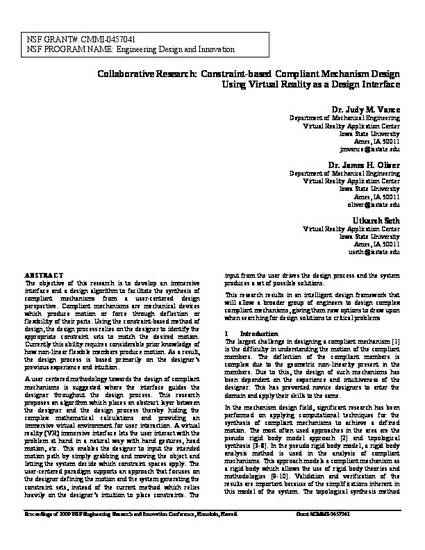
The objective of this research is to develop an immersive interface and a design algorithm to facilitate the synthesis of compliant mechanisms from a user-centered design perspective. Compliant mechanisms are mechanical devices which produce motion or force through deflection or flexibility of their parts. Using the constraint-based method of design, the design process relies on the designer to identify the appropriate constraint sets to match the desired motion. Currently this ability requires considerable prior knowledge of how non-linear flexible members produce motion. As a result, the design process is based primarily on the designer’s previous experience and intuition. A user centered methodology towards the design of compliant mechanisms is suggested where the interface guides the designer throughout the design process. This research proposes an algorithm which places an abstract layer between the designer and the design process thereby hiding the complex mathematical calculations and providing an immersive virtual environment for user interaction. A virtual reality (VR) immersive interface lets the user interact with the problem at hand in a natural way with hand gestures, head motion, etc. This enables the designer to input the intended motion path by simply grabbing and moving the object and letting the system decide which constraint spaces apply. The user-centered paradigm supports an approach that focuses on the designer defining the motion and the system generating the constraint sets, instead of the current method which relies heavily on the designer’s intuition to place constraints. The input from the user drives the design process and the system produces a set of possible solutions. This research results in an intelligent design framework that will allow a broader group of engineers to design complex compliant mechanisms, giving them new options to draw upon when searching for design solutions to critical problems
Available at: http://works.bepress.com/judy_vance/55/

This is a conference proceeding from 2009 NSF Engineering Research and Innovation Conference Proceedings (2009). Posted with permission.